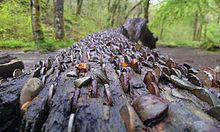Coin tree
A Coin tree ( German coins tree ; also Money tree or Wish tree ) is a tree whose root and branches, if necessary, with hundreds of coins which have been driven through the bark and the wood is covered. It is a more recent form of votive offering . Coin trees are particularly widespread in the north of England and Cornwall, but there are also a few in other parts of the British Isles.
meaning
Originally the depositing of coins was a ritual exchange of values. Material value (coin), against mental or spiritual value. Places of coin donation were especially sacred springs , especially those that were adorned as clootie wells with strips of fabric that were attached to trees. The fact that the strips of fabric were mostly nailed on and only the nails remained after the rotting of the fabric is a stimulus for the custom, which only developed over time, of driving coins into the wood.
For the oldest known coin tree, an oak tree on the island of Maree in Loch Maree in the Scottish Highlands, now completely uprooted and broken into several parts , it was recorded in the mid-19th century that the tree was completely studded with nails. Other metal objects were also attached to the tree. Later all metal objects were designated as suitable gifts to the tree and by 1877 at the latest only coins were struck into the tree.
As far back as the 1940s, traditions are documented according to which a coin tree in Northern Ireland promised to cure typical common ailments such as warts or humps. At the same time, the offerings to this tree are described as hairpins, safety pins, pennies, nails, bolts, and a military badge. When a coin tree falls apart, an immediate neighboring tree is usually used as a successor. In the case of particularly popular coin trees, there were also several, so that in 2014 there were twelve more coin trees around the old, decayed tree at Loch Maree. In modern trees, coins are used almost exclusively.
Surveys of visitors to coin trees who left coins revealed that most of them had never heard of coin trees when they happened upon one. Their rationale for joining the tradition was to want to imitate previous donors, and they assumed it would be a auspicious custom.
distribution
In 2014, 237 coin trees were identified at 32 locations in the British Isles. They are all in rural areas on publicly accessible land, often in tourist areas and on at least regularly used paths. For the oldest known coin tree at Loch Maree, a book from 1775 describes for the first time the custom of laying coins in a tree at a holy spring as a thank you to Saint Maol Rubha for healing from the spring. In 1877 Queen Victoria visited this tree and she and her court left coins. According to contemporary sources, the meaning had already changed, and votive offerings to the saint were named as a motif.
Only a few coin trees can be proven to be of great age; a tree in Argyl , Scotland, one in County Laois , Ireland and one near Ardboe , Northern Ireland have been documented since around the turn of the 20th century. Almost all coin trees come from a resurgence of tradition since the 1990s.
See also
literature
- Mick Sharp: Holy Places of Celtic Britain. London, 1997 Blandford. ISBN 1-85079-315-8
- Ceri Houbrook, Natalie Armitage: The Materiality of Magic: An Artifactual Investigation into Ritual Practices and Popular Beliefs . Oxbow 2015, ISBN 978-1-78570-010-1
- Ceri Houlbrook: Small change: economics and coin-trees in Britain and Ireland. In: Post-Medieval Archeology, Volume 49, Issue 1 (2015), pp. 114–130

